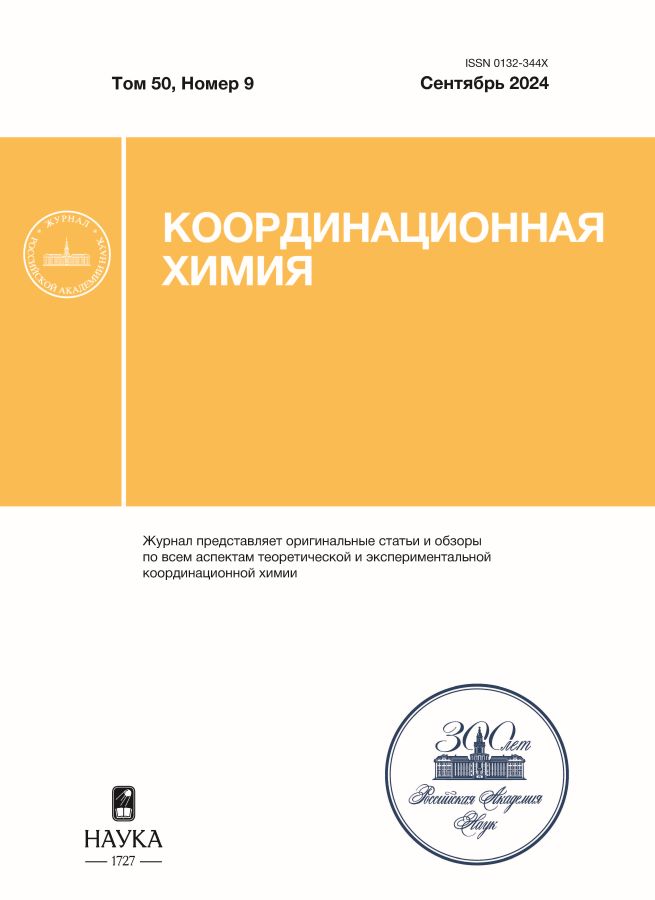Neutral Terbium(III) Tris(complex) with 4,4,5,5,6,6,6-Heptafluoro-1-(1-methyl-1H-pyrazol-4-yl)hexane-1,3-dione: Synthesis, Structure, and Spectral Luminescence Properties
- Authors: Taidakov I.V.1,2,3, Metlin M.T.1, Metlina D.A.1, Goncharenko V.E.1,2, Vlasova T.S.3
-
Affiliations:
- Lebedev Physical Institute, Russian Academy of Sciences
- National Research Institute Higher School of Economics
- Zelinskii Institute of Organic Chemistry, Russian Academy of Sciences
- Issue: Vol 50, No 9 (2024)
- Pages: 592-603
- Section: Articles
- URL: https://rjonco.com/0132-344X/article/view/667665
- DOI: https://doi.org/10.31857/S0132344X24090064
- EDN: https://elibrary.ru/LXJOXE
- ID: 667665
Cite item
Abstract
The reaction of 1,3-diketone containing 1-methyl-1H-pyrazol-4-yl and perfluoropropyl fragments with TbCl3·6H2O in the presence of NaOH in ethanol is studied. The molecular and crystal structures of the complex are studied by single-crystal X-ray diffraction (XRD). Compound [Tb(L)3(EtOH)2] crystallizes in the triclinic crystal system with the space group. The geometry of the coordination polyhedron {LnO8} corresponds to a square antiprism. Intermolecular interactions N…H–O, C–H…O, and C–H…F leading to the formation of supramolecular chains are observed in crystals of the complex. The UV-irradiated complex exhibits green luminescence caused by transitions 5D4 → 7Fj (j = 2–6) characteristic of the Tb3+ ion. The main photophysical luminescence parameters are determined, and the scheme of energy transfer in the complex is proposed. The synthesized compound can be of interest as an independent luminophore or as the initial substance for the synthesis of heteroligand complexes by the substitution of ethanol molecules in the internal coordination sphere.
Full Text
About the authors
I. V. Taidakov
Lebedev Physical Institute, Russian Academy of Sciences; National Research Institute Higher School of Economics; Zelinskii Institute of Organic Chemistry, Russian Academy of Sciences
Author for correspondence.
Email: taidakov@gmail.com
Russian Federation, Moscow; Moscow; Moscow
M. T. Metlin
Lebedev Physical Institute, Russian Academy of Sciences
Email: taidakov@gmail.com
Russian Federation, Moscow
D. A. Metlina
Lebedev Physical Institute, Russian Academy of Sciences
Email: metlinada@lebedev.ru
Russian Federation, Moscow
V. E. Goncharenko
Lebedev Physical Institute, Russian Academy of Sciences; National Research Institute Higher School of Economics
Email: taidakov@gmail.com
Russian Federation, Moscow; Moscow
T. S. Vlasova
Zelinskii Institute of Organic Chemistry, Russian Academy of Sciences
Email: taidakov@gmail.com
Russian Federation, Moscow
References
- Costa I.F., Blois L., Paolini T.B. et al. // Coord. Chem. Rev. 2024. V. 502. P. 215590. https://doi.org/10.1016/j.ccr.2023.215590
- Saloutin V.I., Edilova Y. O., Kudyakova Y. S. et al. // Molecules. 2022. V. 27. № 22. P. 7894. https://doi.org/10.3390/molecules27227894
- De Sa G.F., Malta O. L., de Mello Donegá C. et al. // Coord. Chem. Rev. 2000. V. 196. № 1. P. 165. https://doi.org/10.1016/S0010-8545(99)00054-5
- Chauhan A., Kumar A., Singh G. et al. // J. Rare Earths. 2024. V. 42. № 1. P. 16. https://doi.org/10.1016/j.jre.2023.02.006
- Wu A., Huo P., Yu G. et al. // Adv. Opt. Mater. 2022. V. 10. № 22. P. 2200952. https://doi.org/10.1002/adom.202200952
- Ilmi, R., Kansız, S., Dege, N., Khan, M.S. // J. Photochem. Photobiol. A. 2019. V. 377. P. 268. https://doi.org/10.1016/j.jphotochem.2019.03.036
- Bryleva Y.A., Arteme′v A.V., Glinskaya L.A. et al. // New J. Chem. 2021. V. 45. № 31. P. 13869. https://doi.org/10.1039/D1NJ02441H
- Gontcharenko V.E., Lunev A.M., Taydakov I.V. et al. // IEEE Sens. J. 2019. V. 19. № 17. P. 7365–7372. https://doi.org/10.1109/JSEN.2019.2916498
- Zairov R.R., Shamsutdinova N. А., Fattakhova А. N. et al. // Russ. Chem. Bull. 2016. V. 65. P. 1325–1331. https://doi.org/10.1007/s11172-016-1456-2
- Jia Y., Wang J., Zhao L., Yan B. // Talanta. 2022. V. 236. P. 122877. https://doi.org/10.1016/j.talanta.2021.122877
- Lyubov D.M., Neto A.N.C., Fayoumi A. et al. // J. Mater. Chem. C. 2022. V. 10. № 18. P. 7176. https://doi.org/10.1039/d2tc01289h
- Pavlov D.I, Yu X., Ryadun A.A. et al. // Food Chem. 2024. P. 138747. https://doi.org/10.1016/j.foodchem.2024.138747
- Wang L., Shi C., Zhang C. et al. // Adv. Mater Technol. 2021. V. 6. № 8. P. 2100078. https://doi.org/10.1002/admt.202100078
- Yu X., Ryadun A.A., Pavlov D.I. et al. // Adv. Mater. 2024. P. 2311939. https://doi.org/10.1002/adma.202311939
- de Azevedo L.A., Gamonal A., Maier-Queiroz R. et al. // J. Mater. Chem. C. 2021. V. 9. № 29. P. 9261–9270. https://doi.org/10.1039/d1tc01357b
- Korshunov V.M., Metlina D. A., Kompanets V. O. et al. // Dyes and Pigments. 2023. V. 218. P. 111474. https://doi.org/10.1016/j.dyepig.2023.111474
- de Oliveira T.C., de Lima J.F., Colaço M.V. et al. // J. Lumin. 2018. V. 194. P. 747. https://doi.org/10.1016/j.jlumin.2017.09.046
- Ilmi R., Iftikhar K. // J. Photochem. Photobiol. A. 2017. V. 333. P. 142. https://doi.org/10.1016/j.jphotochem.2016.10.014
- Varaksina E.A., Taydakov I.V., Ambrozevich S.A. et al. // J. Lumin. 2018. V. 196. P. 161. https://doi.org/10.1016/j.jlumin.2017.12.006
- Varaksina E.A., Kiskin M.A., Lyssenko K A. et al. // Phys. Chem. Chem. Phys. 2021. V. 23. №. 45. P. 25748. https://doi.org/10.1039/d1cp02951g
- Taydakov I.V., Krasnoselsky S.S. // Chem. Heterocycl. Compd. 2011. V. 47. P. 695. https://doi.org/10.1007/s10593-011-0821-1
- Sheldrick G.M. SADABS. Program for Scaling and Correction of Area Detector Data. Germany: Univ. of Göttingen., 1997.
- Sheldrick G.M. // Acta Crystallogr. A. 2015. V. 71. P. 3. http://doi.org/10.1107/S2053273314026370
- Sheldrick G.M. // Acta Crystallogr. C. 2015. V. 71. P. 3. http://doi.org/10.1107/S2053229614024218
- Dolomanov O.V., Bourhis L.J., Gildea R.J. et al. // J. Appl. Crystallogr. 2009. V. 42. P. 339. https://doi.org/10.1107/S0021889808042726
- Metlin M.T., Belousov Y.A., Datskevich N.P. et al. // Russ. Chem. Bull. 2022. V. 71. № 10. P. 2187. https://doi.org/10.1007/s11172-022-3645-5
- Taidakov I.V., Lobanov A.N., Vitukhnovskii A.G. et al. // Russ. J. Coord. Chem. 2013. V. 39. P. 437. https://doi.org/10.1134/S1070328413050072
- Taidakov I.V., Vitukhnovskii A.G., Nefedov S.E. // Russ. J. Inorg. Chem. 2013. V. 58. № 7. P. 783. https://doi.org/10.1134/S0036023613070218
- Metlina D.A., Metlin M.T., Ambrozevich S.A. et al. // Dyes Pigments. 2020. V. 181. P. 108558. https://doi.org/10.1016/j.dyepig.2020.108558
- Metlin M.T., Goryachii D.O., Aminev D.F. et al. // Dyes Pigments. 2021. V. 195. P. 109701. https://doi.org/10.1016/j.dyepig.2021.109701
- Petrov A.I., Lutoshkin M.A., Taydakov I.V. // Eur. J. Inorg. Chem. 2015. V. 2015. № 6. P. 1074. https://doi.org/10.1002/ejic.201403052
- Carnall W.T., Crosswhite H., Crosswhite H.M. Energy level structure and transition probabilities in the spectra of the trivalent lanthanides in LaF₃. Argonne, IL (United States): Argonne National Lab., 1978.
- Bünzli J.C.G., Eliseeva S.V. // Lanthanide luminescence: photophysical, analytical and biological aspects. Springer Series on Fluorescence. V. 7. Berlin; Heidelberg: Springer, 2011. P. 1. https://doi.org/10.1007/4243_2010_3
Supplementary files




















